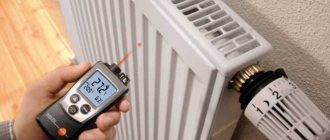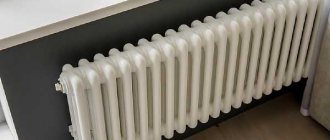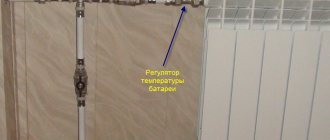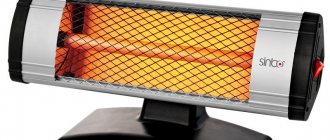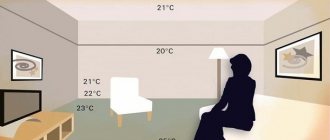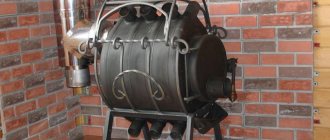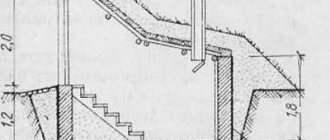In law
- The Housing Code of the Russian Federation establishes criteria for the quality of services in housing and communal services.
- Federal Law No. 190-FZ dated July 27, 2010 “On Heat Supply” regulates relations in the field of heating residential buildings.
- Decree of the Government of the Russian Federation dated May 6, 2011 No. 354 “On the provision of utility services to owners and users of residential premises in apartment buildings” in Appendix 1 lists the requirements for the quality of heat supply (permissible breaks, conditions and procedure for changing fees, air temperature standards).
- Decree of the State Construction Committee of the Russian Federation dated September 27, 2003 No. 170 “On approval of rules and standards for the technical operation of housing stock” describes the requirements for the maintenance of common property. Clause 4.10.2.1 makes it the responsibility of the management company to monitor the air temperature in residential buildings.
- SanPiN 2.1.2.2645-10 “Sanitary and epidemiological requirements for living conditions in residential buildings and premises. Rules and Standards” in Appendix 2 contains temperature indicators for rooms in the apartment.
- SNiP 02/23/2003 “Thermal protection of buildings. The updated edition" fixes the requirements for the temperature of external walls and floors.
Normal battery temperature in an apartment
Several factors influence the heating of a room: thermal conductivity, the order of installation of batteries and a number of other technical characteristics. If the batteries are installed in compliance with all the rules, then their temperature will correspond to the norm. Although there is no law stating the minimum permissible temperature of the batteries themselves.
As for the maximum temperature indicator of batteries in an apartment during the cold season, it is 95°C (subject to a two-pipe heating system). The optimal temperature is 85-90°C, because at 100°C water already boils. Exceeding these temperatures leads to faster failure of the radiator.
What should be the t norm during the heating season?
SanPiN has established requirements for temperature conditions in the cold and warm seasons. In winter, the standards are as follows (see table).
| Room | Optimal, °C | Permissible, °C |
| Corridor | 20–22 | 18–24 |
| Kitchen | 19–21 | 20–24 |
| a guest room | 20–22 | 18–24 |
| Room (bedroom) | 20–22 | 18–24 |
| Children's room | 20–22 | 18–24 |
| Cabinet | 20–22 | 18–24 |
| Toilet | 19–21 | 18–26 |
| Bathroom | 24–26 | 18–26 |
The construction features of apartment buildings and the wear and tear of communications lead to the fact that the first and last floors are colder than others. Moreover, when residents complain to the management company about inconsistencies, these features (cold basement, attic) justify non-compliance with the temperature regime. This is absolutely illegal.
Dear readers!
To solve your problem right now, get a free consultation
- contact the on-duty lawyer in the online chat on the right or call: +7 (499) 938 6124 - Moscow and region.
+7 (812) 425 6761 — St. Petersburg and region. 8 (800) 350 8362 - Other regions of the Russian Federation You will not need to waste your time and nerves
- an experienced lawyer will solve all your problems!
The heating season standards established by the state apply to residential premises regardless of location or floor. Temperatures below the permissible limits are unacceptable, but they can be above the specified level, but not more than 4 degrees.
There is a requirement to install special heating systems for uniform heat distribution in the floors of the first floors. The owners should not be influenced whether their house is brick or panel.
IMPORTANT! Utilities are required to maintain acceptable temperature limits in all apartments from which they charge maintenance fees.
The law sets the bar for optimal room temperature, but everyone will have their own comfortable temperature. Objectively, the feeling of comfort at certain temperatures depends on factors:
- The age of the person. Infants and older people are more heat-loving; they need to maintain a temperature level above average.
- Floor. Typically, women prefer to be in warmer rooms than men.
- Individual characteristics. Some people like coolness; for others, comfort lies in warmth.
When the management system maintains the regime at the proper level in homes, creating comfortable conditions and adjusting the temperature by a couple of degrees is not difficult. For this purpose, there are numerous climate control systems, air conditioners, and heaters.
The most optimal air temperature for humans in different residential areas
Optimal home heating rules are a compromise of the highest possible degree of comfort and concern for the normal functioning of the body. The functions of the rooms are different: heating of the rooms depends on the purpose.
The bathroom is one of the warmest rooms in the apartment
The bathroom is mostly intended for water procedures. Since water promotes thermoregulation, low levels of warming up provoke hypothermia in the body. The optimal bathroom room temperature is 23°C. The bathroom is susceptible to mold due to high humidity: adequate ventilation is especially important.
Children's room - heat only harms
The children's room is a kind of universal room, sometimes used almost around the clock. During the day it serves as a playroom for the little ones. At night, however, children should get as much sleep as possible. During the day, optimal heating levels for a child's room are 20-22°C. Especially when there are babies and young children in the room, it is not recommended to reduce the numbers. At night, however, 18°C is enough even for newborns.
Kitchen, dining room and living room - beware of overheating
In the kitchen, the optimal heating level is 18°C. The stove and other kitchen appliances heat the room: setting high settings for the split system is not recommended in order to avoid overheating. However, if the kitchen also serves as a dining room or living room, it is worth increasing to 20°C. The living room is one of the rooms in the apartment where we spend the most time. Most people do not necessarily actively use the space in the living area: they watch TV here, read a book, talk, or relax. As a result, the optimal heating of the living room is at a relatively high level: depending on the feeling of cold, 20-23°C.
Bedroom
The bedroom, as the name suggests, is mostly used for sleeping. Not only the duration of rest, but also the ideal room climate is decisive for a restful night's sleep. To create an optimal balance during the night's rest, the room heating is not too high: otherwise problems with well-being may arise. Therefore, the most comfortable heating in the bedroom is only 17-18°C. Some experts recommend even lower numbers: 15-18°C. For those especially sensitive to cold, such a low reading may be uncomfortable. It is worth raising the level to 20°C. However, where the thermometer finally stops accurately determines the personal sensation of cold. The ideal state of the surrounding atmosphere - you are not cold, you are not sweating. The indoor climate should be thermoneutral: that is, you should not feel any discomfort externally, and the surrounding space should not attract attention. However, even when relying on internal sensations, the thermometer should not rise above 20°C.
If a person freezes under a blanket, the process of falling asleep is much worse, and at extremely low rates it is almost impossible: the person mistakes dying associated with hypothermia for sleep. When the bedroom is colder than the body needs, instead of recovering, the body must generate energy to keep internal heating constant. In addition, the constant cold in the bedroom causes muscle tension, reducing the recovery effect.
Too high a temperature in the bedroom makes us sweat under the covers. Even just a temperature that is warmer than necessary does not allow us to sleep well: dry indoor air has a negative effect on the body. The consequences are:
- Dry mucous membranes of the mouth and nose.
- Cough.
- Headache.
Timely ventilation and humidity control play an important role for a comfortable night's rest. Excessive humidity not only affects night's sleep, but also offers uninvited guests ideal living conditions: mites in house dust, mold spores ideally reproduce in high humidity, incorrect temperature, poor cleaning.
Air temperature standards according to GOST
The temperature parameters of residential premises are regulated by regulations - SanPiN 2.1.2.2645-10, GOST R 51617-2000 Housing and communal services and general technical conditions, where the temperature regime of rooms is regulated from 18 ° C in winter, from 20 ° C in summer. There is a standard in Government Decree No. 354 on corner rooms and cold regions, where a different acceptable standard is adopted.
The standard air temperature in residential premises is set not lower than +18°C (in corner rooms +22°C), in areas with the coldest five-day period (provision 0.92) -31°C and below, the temperature regime is set to +20°C ( in corner rooms +22°C). Failure to comply with the standard, rather than comfortable, thermal regime is considered a violation.
In corner apartments
Previously, GOST indeed established special rules for corner apartments - 2 degrees higher than usual. Today, the temperature regime is established and regulated by Decree of the Government of the Russian Federation dated May 6, 2011 No. 354.
Exterior walls
The creators of SNiP 02/23/2003 believe that the temperature difference between the internal air and the external surface should be no more than 4 degrees. That is, if the minimum limit for a living space is 18 °C, then the wall on average should not be colder than 14.
When this rule is violated, we can conclude that the house is not insulated enough, and perhaps the seams require updating. The management company servicing the building should take care of this.
Floor
In accordance with SNiP [35], the temperature of the floor surface in residential premises should not be lower than 16 ° C (as a rule, it exceeds the minimum permissible and ranges from 18 to 20 ° C.).
SNiP 41-01.2003 establishes the normal temperature for heated floors:
- 26 °C for rooms where people are constantly present;
- 31 °C for premises where people stay temporarily.
Children's institutions are recommended to maintain the floor at a maximum temperature of 24 °C.
Room temperature standards
The optimal room temperature for a person largely depends on individual needs and other factors. At the state level, this value is regulated by the document GOST 30494–2011 and R 51617−2000. According to GOST, the standard parameters of the indoor microclimate are:
- living rooms - from +20 to 23 degrees. Celsius;
- kitchen and toilet - from +18 to 21 degrees. Celsius;
- bathroom - from +23 to 25 degrees. Celsius;
- corridor, pantry, staircase - from +14 to 19 degrees. Celsius;
- in summer - from +24 to 28 degrees. Celsius;
- in winter - from +22 to 24 degrees. Celsius.
In winter, the temperature in the premises should be 3-4 degrees higher than in summer. Depending
on the purpose of the room, average temperature conditions are determined. For example, it is better to sleep in a well-ventilated room with a temperature of about 22 degrees. In a hotter environment it will be more difficult to sleep, and in a cold environment you will have nightmares.
If the question concerns a children's bedroom, then the temperature in the room should be adjusted depending on the age of the child. Thus, for the baby’s comfortable well-being, it is best to adhere to the maximum permissible temperature regime (+23…+24 degrees). As you grow older, the norm will decrease to the minimum levels comfortable for adults (+19…+20 degrees).
The bathroom has the highest humidity in the apartment, so following the standards of sanitary rules and regulations (SANPIN) in the bathroom is important for personal hygiene. If the indicator deviates from the norm, dampness occurs in the bathroom and mold begins to form.
The appropriate temperature in the kitchen is determined by the type of household appliances that are used in the kitchen, as well as the intensity of their use. Thus, if the kettle and stove are often used in the kitchen, the temperature in the room will be too hot, so you should reduce the degree. However, when using electrical appliances, the temperature in the room will not change, since such devices have a lower level of heat transfer.
Factors that determine comfortable conditions
Standard indicators for a comfortable indoor temperature for a person are based on ideal conditions in which there are no significant seasonal fluctuations, no additional measures are used to increase or decrease the temperature, and all people have the same preferences. In life, determining the optimal living room conditions may depend on a number of factors:
- Various climate zones.
- Significant fluctuations in outside temperature.
- Features of the structure of the house (brick retains heat better than panel ones).
- Human factor. Some people enjoy being in a well-ventilated area, while other people prefer air-conditioned air.
- Women prefer warmth, while men prefer the opposite. Children feel comfortable staying in a room where it’s +21…+23 degrees.
Given the different preferences of each person, it is recommended to adhere to standard norms. The temperature in the room should be comfortable for a particular person.
Where to contact
Small deviations from the norm may go unnoticed, but if residents are constantly freezing in the apartment, this indicates a violation of obligations on the part of utility companies. Especially when heating and maintenance fees are charged in full. Then you need to complain about the poor maintenance of the house.
If t is below acceptable
If it is cold at home, or the temperature is recorded below standard in autumn or winter, you need to report this to the emergency dispatch service. A complaint is written to the head of the management company, which lists the complaints, indicates the air temperature in the living rooms, kitchen, bathroom, and demands that it be brought into compliance with the standards.
The management company is given 30 days to respond. During this period, utility services must find out which of them is responsible for the cooling of the house. If the heating network, at the point of demarcation of balance sheet ownership, is not hot enough, then this is a question of the resource supply organization that heats the room. If heat is lost in the house, then the management company must solve the problem.
ADVICE! It is better to draw up a collective complaint from the residents of the entrance or building.
If the wall freezes
When it is so cold that the end walls freeze, you need to act quickly. It is necessary to contact the head of the management company with a complaint, describe the problem, demand that the wall be insulated, thereby restoring the temperature balance. At the same time, call a representative of the management company, draw up and receive a report on freezing of the wall.
If, after the required period, the Criminal Code does not take action, government authorities will have to be involved in solving the problem:
- The State Housing Inspectorate is an executive body that controls the activities of public utilities. Inspectors will initiate an inspection, issue a recommendation to eliminate violations, and impose a fine on the service organization.
- Rospotrebnadzor is a multidisciplinary organization whose specialization falls under the described situation. Failure of the management company to fulfill the terms of the contract, combined with the risk of increased humidity, the spread of mold and mildew from a frozen wall, is the competence of this service. After checking the activities of the management company, employees will be obliged to bring the house to the requirements of the law, and if there are grounds, they will fine the management.
- The prosecutor's office is a supervisory authority whose employees begin checking a legal entity only if there have been appeals to previous organizations. Or they address the residents’ complaint to the competent authorities to resolve the issue.
- The court is the last step that is taken if other government agencies are powerless or it is necessary to compensate for material and moral damage.
The document is drawn up in a standard manner. Several methods of delivering them to the addressee are allowed. You can bring it yourself, register two copies, and keep one as evidence. Complaints are also sent by registered mail with notification or online through the State Services website.
Heating in an apartment: standards for each room
Each room in the home must have its own suitable temperature regime so that the climate does not negatively affect the health of the apartment’s inhabitants.
Thus, it is worth monitoring the thermometer in each room, for example:
- In any room reserved for sleeping, the temperature should be 17-18 degrees, as this will ensure healthy sleep without headaches.
- For the kitchen, you should take care of the temperature range from 18 to 19 degrees, since there are a large number of heating devices there, which will already increase the air temperature. If you turn on all the appliances at the same time, as when preparing lunch or dinner, it will become very hot and uncomfortable.
- Since the bathroom has the highest humidity in the apartment, the temperature here should be from 24 to 26 degrees Celsius, otherwise there will be a feeling of dampness or it will simply be very chilly to take a shower.
- Stability is important in a children's room, as mentioned above. In addition, it is worth considering that for a newborn the temperature should be quite high, about 24 degrees, and for an older child you will have to reduce the heating of the room a little - to 21-22 degrees.
- The minimum temperature in the apartment should not fall below 18 degrees, while it should not be exceeded above 22 degrees in all other rooms except those named, so as not to cause discomfort.
The normal temperature in the apartment should not vary greatly from room to room, since it will be very uncomfortable to come from a warm room to a cooled kitchen or bath, for example. So you should keep an eye on the difference of 2-3 degrees, no more.
If we take into account the heating standard in an apartment building according to GOST, it is interesting to note that there is no upper temperature limit in the house, but there is a lower limit - 18 degrees Celsius. Thus, each resident should vary the maximum for themselves, if necessary, opening windows and releasing excess heat outside.
In addition, the question “how to measure the temperature in an apartment” remains important, because it is difficult to understand whether the housing complies with GOST or not.
To do this, you need to determine the speed of air flow in the room and humidity. In general, the standard humidity of an apartment in Russia will be about 60%, and indoor winds are unlikely to be stronger than 0.3 m/s. Based on these parameters, with a thermometer reading of 24 degrees, the actual temperature will be 23. If the humidity is slightly higher or there are slightly stronger drafts, the temperature will drop another degree. Thus, the actual temperature rarely matches what the thermometer shows. It is better to comply with heating standards in an apartment, since the human body reacts sensitively to any unfavorable environment around it. You should be especially careful in summer or winter, when owners of air conditioners create a large imbalance between the outside world and their apartment. This provides a lot of stress to the body, which experiences a sharp change in temperature every time, which leads to hypothermia or overheating.
Thus, it is worth trying to adhere to the principle of a difference between home and external temperatures of 4-5 degrees. With this regime, the body will not suffer due to sudden fluctuations and the likelihood of getting sick drops dramatically.
If you surrender completely to personal preferences, then two scenarios are possible:
- Overheat
- Hypothermia
What is the responsibility of utility companies?
The degree of responsibility of the management company depends on the severity of the offense and the consequences.
If utility companies immediately respond to a complaint and eliminate violations, there will be no consequences. When residents have to involve government authorities, punishment is inevitable. The easiest thing is administrative liability, a fine.
If the owners have damaged property or suffered health damage, they can associate this with the low temperature of the house and there is an evidence base for this, then civil proceedings and compensation for damage cannot be avoided.
When the consequences are serious, sanctions are possible, including criminal ones.
Useful video
Details about degrees:
Dear readers! To solve your problem right now, get a free consultation
— contact the lawyer on duty in the online chat on the right or call: +7 (499) 938 6124 — Moscow and region.
+7 (812) 425 6761 — St. Petersburg and region. 8 (800) 350 8362 - Other regions of the Russian Federation You will not need to waste your time and nerves - an experienced lawyer will solve all your problems! Or describe the situation in the form below:

